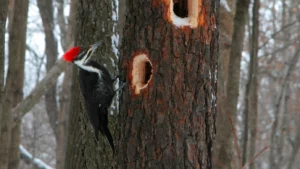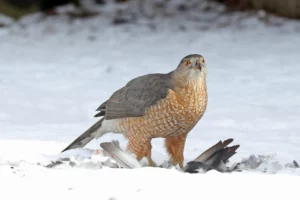Lake Auburn, Carolyn Houtz
Today marks the first day of December. The last few weeks of autumn give way to winter. Animals must ensure they have prepared for the winter’s scarce resources or hibernation. In Mary Hollands Naturally Curious: A Photographic Field Guide and Month-by-Month Journey through the Fields, Woods, and Marshes of New England December is the month of signage:
Many creatures have disappeared from sight. Those that remain include “feeder birds,” whose interactions present an opportunity to assess hierarchy within a flock as well as between species. While there are fewer mammals around, the signs of those that remain active are more evident and change daily. As soon as the first snow falls, animal signs—be they tracks, scat, scent posting, feeding holes, or markings of any kind—offer the observer an intimate look at animal activity. Plants, for the most part, are dormant, with next year’s growth safely sealed within protective buds awaiting lengthening days.
Most amphibians and reptiles are hibernating beneath the mud, soil, leaf litter, and at the bottom of ponds. Many mammals have gone into hibernation, and many birds have migrated to warmer places in the south. As things quiet down in the New England forests, you can really notice the activity that continues into the winter, and the subtle signs of foraging, hunting, and season specific behaviors.
Pileated Wood Pecker photo by Steve S. Meyer
Some locals who stick around for winter are the Hairy and Downy Woodpeckers. You will still hear them pecking away for insects or larvae in trees and branches. They are able to keep warm in the winter due to their plumage, which insulates them well from colder winter temperatures. Another woodpecker you will see is the iconic Pileated Woodpecker. The Pileated Woodpecker is searching for carpenter ants in the heartwood of standing dead trees. Large holes are excavated to access the center of the tree where they will scrape out carpenter ants to feed. After the Pileated Woodpecker is done feeding, the holes excavated may become used as homes for white-footed deermice.
Hunting Coopers Hawk. Photo by Angela Kopenapa
Predators are also on the hunt for a meal this winter too, the Cooper’s Hawk is one searching for their next meal. Cooper’s Hawks are classified as accipiters, meaning they are “birds of prey with short, broad, rounded wings and a long tail that helps them maneuver in the forests where they often reside.” They are skilled at ambushing prey which are commonly birds or small rodents. Another hunter you may see signs of is the Red Fox, whose tracks cut through the woods on the snowy ground. Due to the Red Fox’s fluffy foot, their tracks are often hard to distinguish, rather we look at the pattern of the tracks to identify the fox. They often leave a straight-line pattern because their hind feet follow their front feet directly in their gate. It’s easy to distinguish a fox, coyote, or wolf from a domesticated dog, since a dog’s tracks are much more scattered, and wandering than a wild animal who must conserve energy. Dogs have it easier and need to get out as much energy as possible.
Less appealing signs of activity include scat, a sure way to identify what has been around. White-Tailed Deer can vary due to seasonal diets. Often in the winter small dry pellets can be found in the snow or on the forest floor. A Fisher, who is a predator, will have scat that almost resembles cat droppings. A fisher uses their scat to spread their scent and mark their territory.
It’s not common to think about insects in the wintertime as we don’t see bugs this time of year, but where do they go when the temperature drops. In the case of the Bagworm Moth, the next generation overwinters in their eggs, made from plant matter woven into a “bag”. Carpenter Bees nest in holes in wood for the winter while they go dormant. If you see perfectly round quarter inch holes in wood or logs on the forest floor, chances are there are dormant carpenter bees inside.
As life quiets in December, it’s important to notice that it does not stop. It still persists. The shorter days of winter will give way to the longer days of spring. The cycle of rest is necessary for this ecosystem and climate to maintain a healthy balance. Continue to get outside and notice what to see, smell, and hear in the woods. Ensure you dress warm so you can take your time and continue to note things throughout the late fall and winter.



